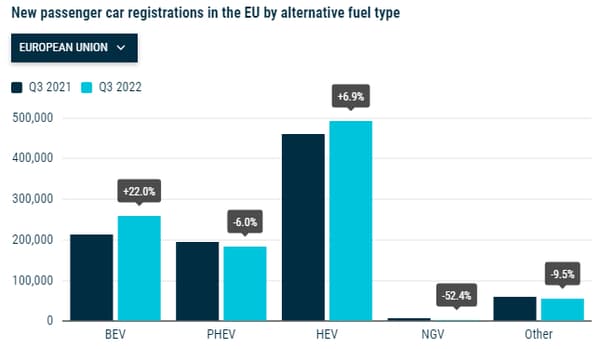In a Europe in full energy transition, it is undoubtedly one of the most versatile engines for both electric and good old fuel driving. The plug-in hybrid (or PHEV, see box at the bottom of the article) allows most of the daily journeys to be carried out in “zero emissions” and to have a fuel tank for longer journeys, such as vacation trips.
Sales fell 6% in one year
A break, however, for this type of model, with a first drop in the share of its sales in Europe in the third quarter. From July to September, plug-in hybrid cars represented 8.5% of new car sales, with 184,000 units, according to the European Manufacturers Association (ACEA).
“Registrations of plug-in hybrid electric vehicles fell by 6% in the third quarter of the year,” says the ACEA press release, which highlights the sharp declines in sales recorded in France (-14.3%) and Italy (-22 ,two%) .

A significant drop for plug-in hybrids, in a European market that is recovering slightly after months of falling sales. Especially compared to its two main competitors in these new engines: 100% electric, with 11.9% of new car sales in Europe in the third quarter, 22% more, and the classic hybrid with 22, 6%, 6.9% more.
The hybrid, increasingly widespread to reduce CO2 emissions from internal combustion cars, is thus the second best-selling engine on the continent, behind gasoline, with 37.8% of new car registrations in the third quarter, and well ahead of Diesel, which fell to 16.5% of the market.
The reasons for a disenchantment
But, what is the reason for this drop in sales when many manufacturers rely heavily on this motor to ensure the transition from thermal to 100% electric? Peugeot, for example, offers its new 408 in a plug-in hybrid version only for the “First edition” launch finish. Renault, however, made the opposite decision for its new SUV, the Austral, which will only be offered with “classic” hybrid engines. Interesting when it is known that its main objective, the Peugeot 3008, is committed to rechargeable hybrids to electrify its sales mix.
First element: the current context, with Europe wanting to impose the sale of new cars that are only 100% electric by 2035. This is also enough to focus the public’s attention on this engine to the detriment of others, such as the rechargeable hybrid, which is also criticized for its real carbon footprint.
“We have talked so much about electric vehicles, the electric vehicle and 2035, that today customers are lost and have many doubts about which vehicle to buy. However, when you buy a vehicle, you think of resale in five, six years. and how much the car will be worth at that time. The question strongly arises about the plug-in hybrid. Is it the right choice?” emphasizes Flavien Neuvy, economist, president of the board of directors of the Cetelem Automobile Observatory.
In this argument, we can also mention the Low Emission Zones (ZFE), the implementation of which will be accelerated in France in the coming years. In Greater Paris, the ban on thermal driving (including hybrids) is planned, for example, for 2030. A still distant horizon, but one that buyers necessarily take into account to anticipate the residual value of the vehicle. Like the manufacturers, who trust the thermal less and less.
“Manufacturers have understood that plug-in hybrids will not pass Cafe 2035 (the European regulation governing CO2 emissions, editor’s note). They are very expensive vehicles because there are two technologies. However, the manufacturers will have to develop the next generation and no longer invest in the thermal engine”, explains Eric Champarnaud, partner of the firm C-Ways, for whom this engine will not exceed 10% of sales.
Another more global element: a complex economic context that forces companies to postpone the purchase of cars.
“Rechargeable hybrids were bought massively by companies, unlike electric ones. However, with the economic context, companies are drastically reducing their expenses,” stresses François Roudier, spokesman for the Automotive Industry Platform.
Three main families of hybrids
The plug-in hybrid car (or PHEV for “plug-in hybrid electric vehicle”) designates a plug-in hybrid automobile (the “plug-in”). In fact, its battery is large enough to drive in 100% electric mode for more or less 50 kilometers.
This is the main difference with “classic” or non-rechargeable hybrid cars: a technology popularized by Toyota and that will only allow consumption to be reduced, not really allowing 100% electric driving (or only at start-up or in a much reduced range of use). Attractive argument: it is not necessary to plug it in, the small battery is recharged thanks to the energy recovered during deceleration. Toyota recently spoke of “self-charging” hybrid cars, to emphasize this point in relation to 100% electric cars and rechargeable hybrids.
Last category: “light hybrids” or “mild hybrids”. An alternator-starter will support the engine during acceleration phases, but no electrical energy is transmitted to the wheels.
Source: BFM TV

